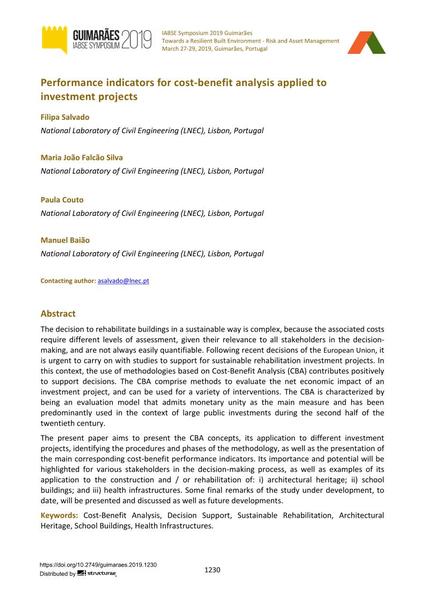Performance indicators for cost-benefit analysis applied to investment projects

|
|
|||||||||||
Bibliographic Details
| Author(s): |
Filipa Salvado
(National Laboratory of Civil Engineering (LNEC), Lisbon, Portugal)
Maria João Falcão Silva (National Laboratory of Civil Engineering (LNEC), Lisbon, Portugal) Paula Couto (National Laboratory of Civil Engineering (LNEC), Lisbon, Portugal) Manuel Baião (National Laboratory of Civil Engineering (LNEC), Lisbon, Portugal) |
||||
|---|---|---|---|---|---|
| Medium: | conference paper | ||||
| Language(s): | English | ||||
| Conference: | IABSE Symposium: Towards a Resilient Built Environment Risk and Asset Management, Guimarães, Portugal, 27-29 March 2019 | ||||
| Published in: | IABSE Symposium Guimarães 2019 | ||||
|
|||||
| Page(s): | 1230-1236 | ||||
| Total no. of pages: | 7 | ||||
| DOI: | 10.2749/guimaraes.2019.1230 | ||||
| Abstract: |
The decision to rehabilitate buildings in a sustainable way is complex, because the associated costs require different levels of assessment, given their relevance to all stakeholders in the decision- making, and are not always easily quantifiable. Following recent decisions of the European Union, it is urgent to carry on with studies to support for sustainable rehabilitation investment projects. In this context, the use of methodologies based on Cost-Benefit Analysis (CBA) contributes positively to support decisions. The CBA comprise methods to evaluate the net economic impact of an investment project, and can be used for a variety of interventions. The CBA is characterized by being an evaluation model that admits monetary unity as the main measure and has been predominantly used in the context of large public investments during the second half of the twentieth century. The present paper aims to present the CBA concepts, its application to different investment projects, identifying the procedures and phases of the methodology, as well as the presentation of the main corresponding cost-benefit performance indicators. Its importance and potential will be highlighted for various stakeholders in the decision-making process, as well as examples of its application to the construction and / or rehabilitation of: i) architectural heritage; ii) school buildings; and iii) health infrastructures. Some final remarks of the study under development, to date, will be presented and discussed as well as future developments. |
||||
| Keywords: |
school buildings cost-benefit analysis Architectural heritage Decision Support sustainable rehabilitation Health Infrastructures
|
||||
